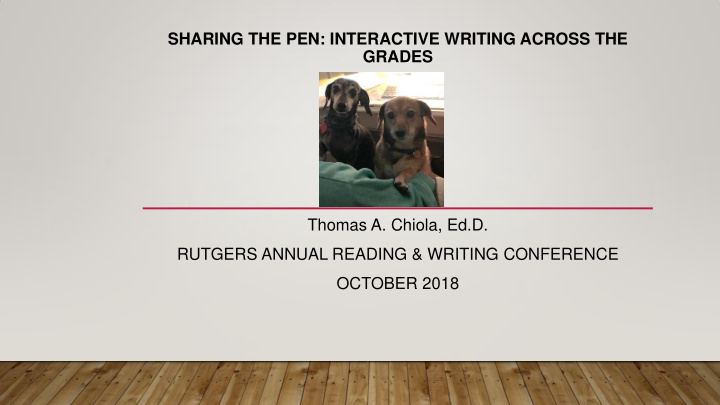



SHARING THE PEN: INTERACTIVE WRITING ACROSS THE GRADES Thomas A. Chiola, Ed.D. RUTGERS ANNUAL READING & WRITING CONFERENCE OCTOBER 2018
BLOCK PARTY ! After reflecting on your quote, find 3 people to share your quote with in rounds of two minutes each. We will then come back together to share insights gained from the sharing of the quotes.
WORKSHOP AGENDA • Welcome! Block Party • What is Interactive Writing? • Why implement sharing the pen? • What are the steps/routines of in an Interactive Writing lesson ? • What does a lesson plan look like? ( samples of K-5 grade) • Shaping Up/ Next Steps
INTERACTIVE WRITING WHAT IS IT? • “Interactive writing is a dynamic instructional method during which the teacher serves as the expert writer for her students as they work together to construct a meaningful text while simultaneously discussing the details of the writing process. Together they plan , compose , and review text in a variety of genres. The interactive piece involves group collaboration in planning and composing the writing through guided conversation and a unique ”sharing the pen” technique where students do the actual writing.” Roth & Dabrowski (2016)
WHAT DOES THE RESEARCH SAY ABOUT INTERACTIVE WRITING ? • “Because children actively participate in the writing of the text and reading it many times in the process, the intention is that they create a text that is accessible and readable” (Roth & Guinee, 2011, p. 335). • Students who participate in interactive writing show growth on multiple measures of independent writing. Students are able to transfer many skills and strategies addressed in each lesson. • Interactive writing is an effective way to differentiate instruction within a whole-class lesson. • Interactive writing is relatively easy to implement in that it is cost-and time-effective. Minimal materials are needed, and the lessons are relatively short in duration.
INTERACTIVE WRITING ROUTINES: BREAKING IT DOWN • Experience-writing motivated by a shared classroom experience • Prewrite- Purpose, audience, structure • Compose – focus on craft elements ( organization, word choice, etc. • Share the Pen – teacher & student write the text, teacher writes, student writes, negotiation, connect to students independent writing, incorporate visuals, share the piece with intended audience
EXAMINING SAMPLES OF LESSONS • With your grade level groups, look over the lesson samples and discuss your noticings and what resonates with you. • Think about you’re your own curriculum, what experiences do you and your students share throughout the year that would provide opportunities for interactive writing and sharing of the pen? • Social studies, science and or math unit experiences? • Share out
WRAP UP: SHAPING UP • On your index card, please write down, first: • What did you hear, share and discuss what squared with your thinking about interactive writing? • What questions do you still have about interactive writing? • What will you do tomorrow to incorporate or lift the level of your interactive writing in your classroom?
REFERENCES • Brotherton, S., & Williams, C. (2002). Interactive Writing instruction in a first-grade Title I literacy program. Journal of Reading Education, 27(3), 8-19. • Roth, K. & Dabrowski, J. (2016). Interactive Writing Across the Grades. Stenhouse, Publishers.
Recommend
More recommend